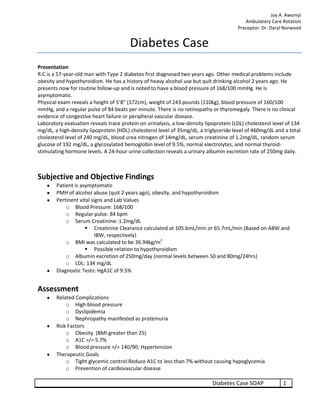
Managing Type 2 Diabetes and Related Conditions
- 1. Joy A. Awoniyi Ambulatory Care Rotation Preceptor: Dr. Daryl Norwood Diabetes Case Presentation R.C is a 57-year-old man with Type 2 diabetes first diagnosed two years ago. Other medical problems include obesity and hypothyroidism. He has a history of heavy alcohol use but quit drinking alcohol 2 years ago. He presents now for routine follow-up and is noted to have a blood pressure of 168/100 mmHg. He is asymptomatic. Physical exam reveals a height of 5’8” (172cm), weight of 243 pounds (110kg), blood pressure of 160/100 mmHg, and a regular pulse of 84 beats per minute. There is no retinopathy or thyromegaly. There is no clinical evidence of congestive heart failure or peripheral vascular disease. Laboratory evaluation reveals trace protein on urinalysis, a low-density lipoprotein (LDL) cholesterol level of 134 mg/dL, a high-density lipoprotein (HDL) cholesterol level of 35mg/dL, a triglyceride level of 460mg/dL and a total cholesterol level of 240 mg/dL, blood urea nitrogen of 14mg/dL, serum creatinine of 1.2mg/dL, random serum glucose of 192 mg/dL, a glycosylated hemoglobin level of 9.5%, normal electrolytes, and normal thyroid- stimulating hormone levels. A 24-hour urine collection reveals a urinary albumin excretion rate of 250mg daily. Subjective and Objective Findings Patient is asymptomatic PMH of alcohol abuse (quit 2 years ago), obesity, and hypothyroidism Pertinent vital signs and Lab Values o Blood Pressure: 168/100 o Regular pulse: 84 bpm o Serum Creatinine: 1.2mg/dL Creatinine Clearance calculated at 105.6mL/min or 65.7mL/min (Based on ABW and IBW, respectively) o BMI was calculated to be 36.94kg/m2 Possible relation to hypothyroidism o Albumin excretion of 250mg/day (normal levels between 50 and 80mg/24hrs) o LDL: 134 mg/dL Diagnostic Tests: HgA1C of 9.5% Assessment Related Complications o High blood pressure o Dyslipidemia o Nephropathy manifested as proteinuria Risk Factors o Obesity (BMI greater than 25) o A1C >/= 5.7% o Blood pressure >/= 140/90; Hypertension Therapeutic Goals o Tight glycemic control:Reduce A1C to less than 7% without causing hypoglycemia o Prevention of cardiovascular disease Diabetes Case SOAP 1
- 2. Goal blood pressure for patients with diabetes is <130/<80 Reduce CVD risks by maintaining healthy cholesterol levels. LDL goal should be <100 No current medications were mentioned. There is a need for therapy in order to lower A1C and manage the patient’s diabetes and related conditions. Plan Further Tests and Work-Up Liver function tests Repeat blood pressure to confirm hypertension CBC to rule out and monitor for infections More detailed history needed o List of medications (current and failed therapies) o Family history o Previous immunizations o Medication Regimen adherence and barriers to adherence Treatment Recommendation: To manage his diabetes, I recommend that the patient be started on Metformin 500mg once daily in addition tothe initiation of lifestyle modifications. This dose may be increased to twice daily dosing as needed or as tolerated every 1-2 weeks with a maximum dose of 2 grams daily. In the management of diabetes for this patient, drugs that may cause the patient to gain weight should be avoided. The patient’s blood pressure should be managed with an ACE Inhibitor such as Lisinopril 10mg daily. Once daily dosing would be ideal and his choice of ACE-inhibitor should be related to the price for the patient as most ACE inhibitors exhibit similar profiles. Hydrochlorothiazide may be added for additional control and numerous preparations are available as combinations of ACE-inhibitors and thiazide diuretics. A beta-blocker is not recommended at this point in therapy due to the masking of hypoglycemia that may accompany a new diabetes regimen. Drug therapy is also recommended for this patient to control cholesterol since the values are above 130. A reduction of LDL to 99 from 134 is a 26.11% reduction. In a comparison evaluating multiple trials with endpoints to reduce cardiovascular disease risks in patients with diabetes, Simvastatin appears to have showed the most benefit in the 4S-DM study where doses between 20 and 40mg daily demonstrated an absolute risk reduction of 42.5% and LDL reduction of 36%. Simvastatin 20mg daily is recommended as initial treatment for this patient. Although diabetics are prone to increase in clot formation, Aspirin daily is not recommended at this point in therapy for this particular patient. He is not as high risk and has no evidence of CHF or peripheral vascular disease. Goals and Monitoring Parameters Metformin use requires routine monitoring of liver function tests and serum creatinine. The urine should also be monitored for glucose and ketones. ACE inhibitor therapy requires monitoring of electrolyte levels (potassium, in particular), blood pressure, renal function, and BUN. Simvastatin use warrants the monitoring of LFTs, as well as Creatinine Kinase, which is indicative of myopathies associated with the medication. 2 Diabetes SOAP Case
- 3. Joy A. Awoniyi Ambulatory Care Rotation Preceptor: Dr. Daryl Norwood Weight changes should be monitored to assess the need for more aggressive treatments or diet restriction. Monitor Carbohydrate and fat intake. Total fat should be less than 7% of the total calories. Target Levels: o A1C Less than 7% Monitor every 2-3 months. o Blood pressure Less than 130/80 Monitor at every routine visit o LDL Less than 100 Lipid assessments may be repeated every 1-2 years Routine tests should be performed to evaluate the efficacy of therapy as well as to monitor the progression of diabetes to prevent further complications o Eye exams annually o Serum creatinine at least annually o Foot examination o Screening for neuropathies Patient Counseling To reduce GI side effects, take metformin with food. Avoid drinking alcohol. In addition to its contributions to hyperglycemia, alcohol has a negative interaction on the drugs Metformin and Simvastatin that can cause liver toxicities. To achieve adequate control of diabetes, lifestyle modifications are an important part of therapy. Dietary restrictions, increase in physical activity, and gradual weight loss will be more beneficial than taking medication, alone. o Exercise should include aerobic activities, such as swimming, walking, or running, at least 3 days during each week. Diabetes Case SOAP 3
